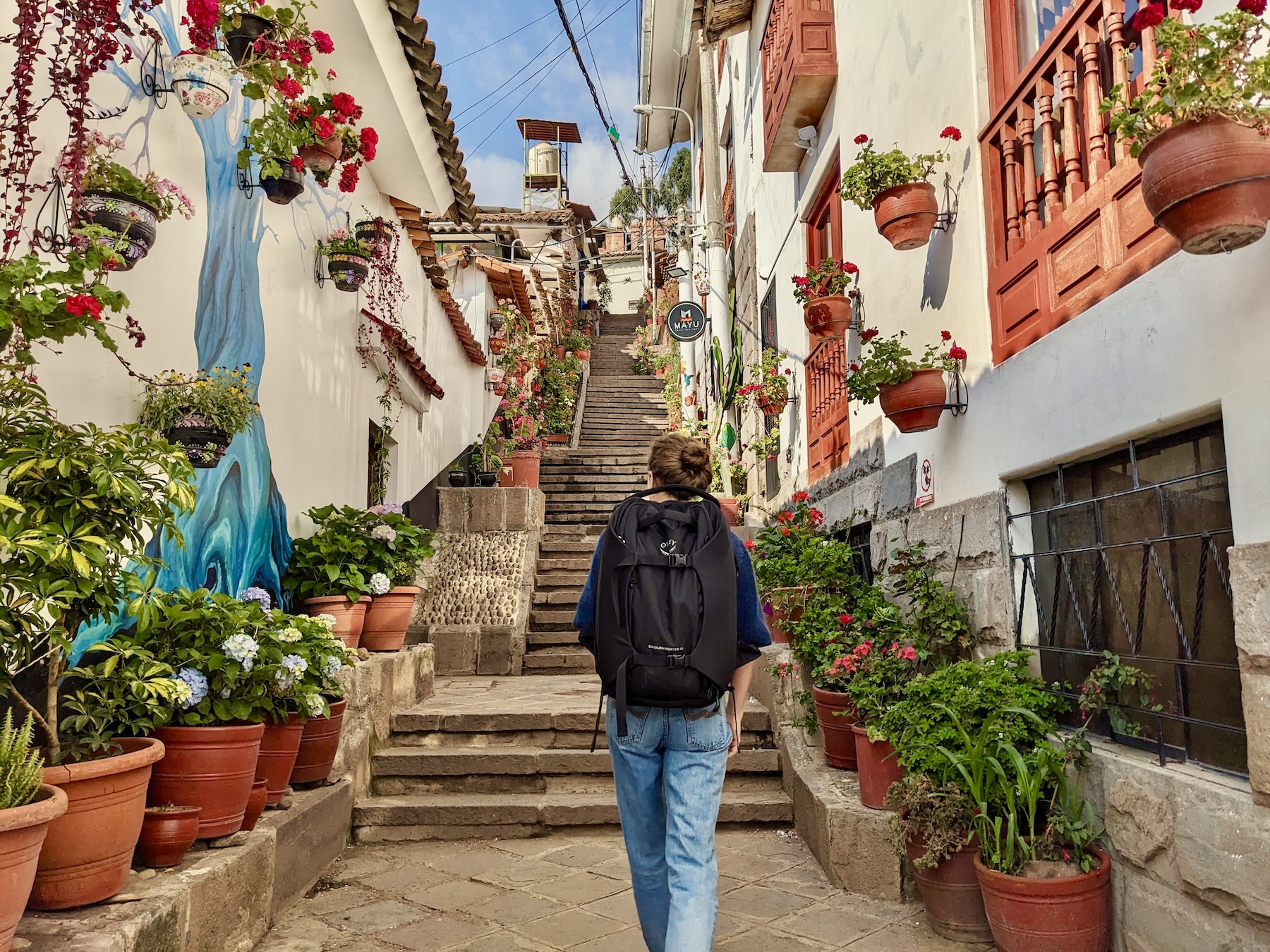Travel Packing Hacks

These 19 travel packing hacks will have you packing like a pro. These hacks will make your travel packing easier and more efficient. They’ll help you to save space through optimising your packing and reducing travel kit that you don’t need.
We’ve all packed overzealously before and ended up regretting those additional dresses and shoes that we’ve had to haul around. This list of travel packing hacks helps you to know where you reduce without regret.
Choose Your Luggage Size First
Before you even start thinking about what to pack and how to pack it, decide on what bag you’re taking. My number one hack is to choose a backpack or suitcase size based on the length of your trip. This will encourage you to only pack what you need because you’ve limited your space. If you take a big suitcase for a week-long holiday, you will end up packing it to max capacity with loads of stuff you don’t need. A bad idea because it’s both heavy and increases carbon emissions from flights!
Here are the ideal bag sizes based on trip length:
- If it’s a weekend away, an everyday 25L backpack is enough. We use an Eastpak (24L).
- If you’re spending 1-2 weeks away, opt for a 35L backpack. We have an old Fjallraven 35L for these trips.
- For trips that are 2-8 weeks, upgrade to a 45L backpack. We highly recommend the Osprey Sojourn Porter (46L).
- For a significant backpacking trip that’s 2+ months, a 45L backpack and a day pack may be enough. If you won’t be moving around too much, then opt for a bigger suitcase like the Osprey Sojourn Wheeled Suitcase (80L).
The only exception to this rule are trips that require more bulky kit that takes up space, such as ski trips or hiking trips. In these cases, opt for a larger bag or suitcase. Make sure to check airline baggage rules so you don’t get charged for excess luggage.
Check the Weather Forecast
Check the forecast in your destination before you start packing and select clothing according to this. You don’t need to pack for all seasons, unless the weather forecast is wild! The one item I do almost always pack regardless of the forecast is a light rain jacket as past experience has taught me that it’s risky to be without one.
Use a Travel Packing Checklist
A travel packing checklist (I’ve got a good one!) is essential so that you both don’t forget anything important or start to get tempted to pack more than you need. Match your packing checklist to the weather where you’re going so that you only pack the clothing you need for the trip.
Opt for Smart Luggage
You might be wondering what an earth I mean by “smart” luggage. Well-constructed backpacks and cases optimise your packing through nifty features such as in-built compression and liner pockets for better organisation.
Osprey packs are particularly designed with smart features. The Osprey Sojourn backpack and Sojourn Suitcase I mentioned above have unique straight jacket compression which means they pull in and compress the contents. I also love this feature because it means the backpack folds neatly and compresses down to a smaller size when empty. Both also feature inside pockets and additional storage compartments for efficient packing.
Use Packing Cubes
Once you’ve used packing cubes, you’ll never go back. These small, zippered pouches help keep your belongings organised within your luggage and compress it down further. As packing cubes are neat, well, cube shapes, it means your bag’s contents stack easily too. The Osprey Ultralight Packing Cubes are a good option. Compression bags are another good option. These vacuum-seal clothing, reducing volume even further. Check out how easy it is to pack using packing cubes.
Only Bring What You’ll Wear
One of the most overlooked travel packing tips is only to bring what you’ll wear and to be brutal about it. If you’ve not worn a standard clothing item in the past month, don’t bring it because you won’t wear it. The only exceptions are items such as your swim kit which you’d need for a beach holiday even if you’ve not recently worn it.
Roll Your Clothes
Rolling clothes instead of folding them saves space and minimises wrinkles. Separate out clothing types into different packing cubes and roll them individually, lining them inside the packing cube like a tray of jam roly-polys.
Wear Bulky Items
Wear your bulkiest clothing items, like puffer jackets or hiking shoes, during travel to save space in your bag. I tend to only do this if I’ll be comfortable wearing these items whilst travelling. I rarely wear my hiking shoes on flights, but I often keep a puffer jacket with me as it doubles as a pillow.
Limit Shoes
Shoes are heavy space-eaters. Only bring the shoes you need for your trip. In most cases, I only bring two pairs of shoes: a pair of trainers that I can hike in and a pair of sandals. The exception is if I’m doing multi-day hikes and need a pair of sturdy hiking shoes too.
Store Socks Inside Shoes
Maximise space by placing socks inside your shoes.
Pack Heavy Items First
If you are bringing hiking shoes for example, pack those first so they’re at the bottom of your case. You can more easily position the rest of your kit around them. Packing them at the bottom means your softer items won’t get crushed and you won’t be off-kilter with your backpack on.
Use Travel-Size Toiletries
Use travel-sized toiletries to save space and refill these at your accommodation as you move. If you’re staying put in one or two places when you reach your destination, then simply opt to purchase most of your toiletries when you’re there.
Use Ziplock Bags
Keep small items like cables and accessories organised in clear ziplock bags. This is also a good idea if you’re bag isn’t waterproof to make sure nothing important gets damp.
Carry a Travel Towel
Definitely, definitely don’t pack a normal towel. Not only do almost all accommodations have towels there, but these bulky, fluffy items are a waste of space. If you need a towel for the beach, pool or camping, use a lightweight microfibre travel towel.
Bring Two Empty Tote Bags
I take two empty tote bags with me on every trip. One is for use at supermarkets and to carry with me during the day, and the other is to separate out dirty laundry. Your dirty washing tote bag should have clothes rolled, the same as your clean clothes packing, and can be stored inside a packing cube if you’re taking dirty clothing with you.
Downsize Your Wallet
Somehow our purses and wallets get overcrowded with coffee shops points cards and all sorts. Take all of this out before travelling or use a separate wallet specifically with your travel credit and debit cards. Make sure not to carry around cards you don’t need. I recommend just a credit or debit card that doesn’t charge foreign transaction or withdrawal fees.
Pack a Kindle instead of Books
I’m an English Lit graduate, so I don’t say this lightly to fellow book lovers, but a Kindle is the better option. You can carry endless books at a lighter weight than carry paperbacks. I load up my Kindle with a few good books I want to read ahead of every trip so that I’m fully prepared. It’s honestly one of my favourite space-saving and weight-reducing travel packing hacks.
Use TSID Luggage Tags
TSID luggage tags are a nifty alternative to old fashioned luggage tags. Instead of writing luggage tags by hand, TSID ones can be registered online using a QR code. It’s super quick and easy. If your luggage gets lost, whoever finds it only needs to scan the QR code to then find your details and contact you. Osprey packs have TSID luggage tags and registration included on every bag.
Prepare to Leave Space
When you’re packing, prepare yourself to leave space in your luggage so you can bring back souvenirs or gifts. Just because you have some free space doesn’t mean you should fill it all up. You’ll be glad to have that space when you arrive in your destination, especially in countries where local handicrafts are common!
What’s your favourite travel packing hack? Share with me in the comments!




